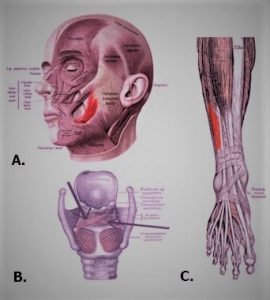
Exclusively-human muscles found in apes
Summary: A recent finding suggests that apes do have the muscles for bipedalism, vocal communication, and facial expressions that were largely held exclusive to humans.
When Planet of the Apes hit the big screen, many of us thought it was a far-fetched display of what could have been if apes were able to act, speak, and think like humans do. Of course, it was a downright fictional movie and was great at that. What comes first to mind is the concept’s plausibility. In essence, humans possess the distinctive capabilities for vocal communication, facial expressions, and prolonged bipedalism that closely-related apes do not display. It seems that the apes lack the muscles purportedly “unique” to humans. However, this notion may be completely overturned. A recent finding suggests that apes do have the muscles for bipedalism, vocal communication, and facial expressions that were largely held exclusive to humans.
Human muscles lacking in apes?
How is it possible that humans can talk and walk but apes cannot? Is it because the apes do not have the necessary muscles? A long-held theory elucidates that apes cannot speak and walk like we do because they lack the muscles essential for vocal communication and full-time bipedalism. These muscles are dubbed as “uniquely human” since nobody has them but humans. Examples of these muscles are fibularis tertius (also called peroneus tertius, a lower limb muscle linked to effeicient bipedalism), musculus arytenoideus obliquus (or oblique arytenoid, a laryngeal muscle used for vocal communication), and risorius (a facial muscle involved in facial expression).1
The exclusively-human muscles helped, particularly, the modern human species, to veer away from an arboreal way of life. Our ancestors used to live above the ground on the trees just so they could evade predators and at the same time have access to food, such as fruits and insects. Eventually, they developed new habits. They expanded their food choices. They became skilled hunters. They enriched their social interactions. The pressure of a risky bipedal habit on the ground teeming with predators perhaps pushed our ancestors to living in groups. Soon, they acquired features that made them very well adapted to living life on the ground. One of them is muscle adaptations. For instance, humans evolved an opposable thumb that enabled multitasking and tool use. A full-time bipedal would also need to balance and center the force of gravity on two feet. Thus, a thigh bone with an inward slope down the knee eventually developed. This enabled the gluteal abductors to adapt efficiently to the stress. Apparently, humans lost certain features (such as the flexible plantaris muscle in foot essential for grabbing and gripping) but gained important attributes that helped thrive on the ground.

A. Risorius, a facial muscle involved in facial expression (in bright red)
B. Musculus arytenoideus obliquus, a laryngeal muscle used for vocal communication (see arrows)
C. Fibularis tertius also called peroneus tertius, a lower limb muscle linked to efficient bipedalism (in bright red)
Exclusively-human muscles found in apes
A study on ape anatomy1 published in Frontiers in Ecology and Evolution posits that the seven muscles linked to sophisticated vocal communication, facial expressions, bipedalism, and tool use once thought as “unique” to humans were present in apes as well. The muscles found in certain ape species even included fibularis tertius, musculus arytenoideus obliquus, and risorius.
The author, Rui Diogo, an Associate Professor at Howard University, USA refuted the long-held theory that such muscles are unique to humans. His findings contradicted this perception on human muscle evolution. He explicates, “Our detailed analysis shows that in fact, every muscle that has long been accepted as ‘uniquely human’ and providing ‘crucial singular functional adaptations’ for our bipedalism, tool use and vocal and facial communications is actually present in the same or similar form in bonobos and other apes, such as common chimpanzees and gorillas.”2
Due to the anatomical studies on apes are scarce, the long-held theory on exclusively-human muscles has not been defied with substantial empirical data but now.
In another study3 published in the Proceedings of the National Academy of Sciences, a team of researchers looked at the molecular features of the muscle fibers of the thigh and calf muscles of an ape group, the chimpanzees (Pan spp.). They found out that the chimpanzees had twice more myosin heavy chain II (MHC II, also referred to as the fast-twitch fibers) in those muscle areas than humans. In contrast, humans had higher myosin heavy chain I (MHC I, also referred to as the slow-twitch fibers) content than the chimpanzees. Their findings indicate that our human ancestors seemingly traded off strength for endurance, which was more crucial in a life of roaming and foraging.
Many people believed that humans are far more superior than our ape relatives. Our sophisticated vocal communication, facial expression, and full-time bipedalism are simply unmatched. However, these studies point out that humans were not that grander. While we could be better in terms of endurance, some of the apes are indeed physically sturdier than us. They even have muscles that were previously thought as exclusive to us. In essence, we did lose certain physical attributes that our closely-related apes retained for their worth in an arboreal way of life. Even so, we gained a leeway to living life on the ground, which we could meekly consider a human milestone.
— written by Maria Victoria Gonzaga
References
1 Diogo, R. (2018). First Detailed Anatomical Study of Bonobos Reveals Intra-Specific Variations and Exposes Just-So Stories of Human Evolution, Bipedalism, and Tool Use. Frontiers in Ecology and Evolution, 6. DOI: 10.3389/fevo.2018.00053
2 Frontiers. (2018, May 23). ‘Uniquely human’ muscles have been discovered in apes: Apes also have muscles long-believed to be only present in humans and used for walking on two legs, using complex tools, and sophisticated facial and vocal communication. ScienceDaily. Retrieved from www.sciencedaily.com/releases/2018/05/180523145842.htm
3 O’Neill, M.C., Umberger, B.R., Holowka, N.B., Larson, S.G., and Reiser, P.J. (2017). Chimpanzee super strength and human skeletal muscle evolution. PNAS , 114 (28): 7343-7348. Retrieved from https://doi.org/10.1073/pnas.1619071114

